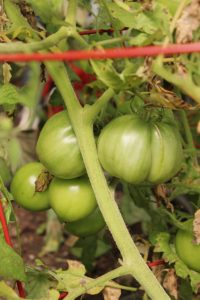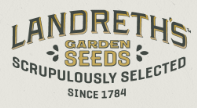Tomatoes
Suppliers
Landreth’s place in history includes so much more than what was planted in the ground. The company also created tools and machines to work the soil for optimal sowing and growing. Landreth pioneered the first grain and seed threshers, built some of the first mowers, reapers, plows, and corn shellers, and, in 1872, developed the first steam-powered tractor for plowing fields. In addition, David Landreth himself published the first floral and horticultural magazine in Philadelphia, and also served as the president of the U.S. Agricultural Society for several terms.
For over 230 years, D. Landreth Seed Company has grown the crops that have built our nation, and we plan to be here for generations to come. From the early days of our country's first farmers to the modern times of farm and garden to table, we have remained your trusted source for the most reliable seeds…as well as your go-to resource for all the growing guides, planting advice, and gardening encouragement you need. We've known, sown, and grown our seeds for centuries, and our assortment reflects those we've scrupulously selected to ensure your gardening success. Sow, grow, know, and most importantly, have fun digging in! We're here for you every step of the way.
Tomatoes Growing Guides
- Penn State - Tomato | Diseases and Pests, Description, Uses, Propagation
- University of Minnesota - Growing tomatoes in home gardens | UMN Extension
- Garden Savvy - How to Grow Tomatoes
- University of Arizona - Growing Tomatoes | Cooperative Extension | The University of Arizona
- Clemson University - Tomato | Home & Garden Information Center
Tomatoes were cultivated from a wild plant native to South America and were grown by the Aztecs and throughout the Americas. They were slow to be adopted in Europe because it was thought they were poisonous. They are related to the nightshade, and the leaves and stems are poisonous, so don’t let your pets eat the leaves or stems! With a few exceptions, tomatoes were not widely adopted in the West, including the United States, until the 1800s. Today, tomatoes are probably the most commonly planted vegetable for at-home gardening, and you could argue that there are more varieties of tomatoes than any other seasonal fruit with well over 5,000 varieties. They are productive and easy to grow within some common-sense guidelines. Tomatoes are eaten sliced and raw, steamed, boiled, stir-fried, baked, roasted, and almost any other way you can imagine.

Tomatoes were cultivated from a wild plant native to South America and were grown by the Aztecs and throughout the Americas. They were slow to be adopted in Europe because it was thought they were poisonous. They are related to the nightshade, and the leaves and stems are poisonous, so don’t let your pets eat the leaves or stems! With a few exceptions, tomatoes were not widely adopted in the West, including the United States, until the 1800s. Today, tomatoes are probably the most commonly planted vegetable for at-home gardening, and you could argue that there are more varieties of tomatoes than any other seasonal fruit with well over 5,000 varieties. They are productive and easy to grow within some common-sense guidelines. Tomatoes are eaten sliced and raw, steamed, boiled, stir-fried, baked, roasted, and almost any other way you can imagine. 
There are three basic categories of tomatoes: Slicers, Cherries, and Sauce tomatoes (also called paste tomatoes), which pretty much divides them by how they are commonly used. Slicers include the large Beefsteak types like Cherokee Purples, Big Boys, and others, as well as Globe tomatoes like the Early Girl, and Better Boy, and the large elongated Oxheart tomatoes. Cherry tomatoes are the familiar small bite-sized round tomatoes. Sauce or paste tomatoes are called that because they are usually used for tomato sauce or tomato paste or cooked in other ways. They are smaller and usually oval-shaped and include Roma tomatoes, “Banana” tomatoes, and several other types. Individual varieties of tomatoes come in all colors, from dark red to light red, yellow, orange, green, or even black and blue!
All these varieties can be either vining types or bush types. Bush tomatoes, often called “determinate,” are good for containers, but can easily be grown in the garden. Bush types don’t usually need a trellis, are smaller, and will produce fruit that ripens all at once. Vining types, the “indeterminate” tomatoes, are good for the garden. They can sometimes be grown in containers if you are able to use a trellis or a good-sized tomato cage. These are larger, sometimes as tall as 7 feet, and need to be staked, grown on a trellis, or supported by something. Their fruit ripens on the vines at different times throughout the season.
- Tomato: Solanum lycopersicum
- Perennial, grown almost always as an annual
- Full sun (6-8 hours minimum)
- Soil acidity slightly acidic (6.0-6.8 pH)
- Well-drained, fertile soil (not clay)
- Garden planting:
Start seedlings indoors, 6-8 weeks before the last frost.
½” deep
Plant seedlings in the garden 2 weeks after last frost.
Space the plants 36” apart
- Climate Zones 4-13
- Container planting:
Start seedlings indoors separately, 6-8 weeks before planting.
½ ” deep
Pots 12-18″ deep or deeper (a 5-gallon container is ideal),
1 plant per pot
Tomatoes all share the same basic flavor, though some varieties are sweeter, some more tart. The sauce varieties become more flavorful when cooked. Tomatoes are extremely healthy and are a well-known source of Vitamin C and potassium, as well as Vitamin A, phosphorus, and calcium. They have a variety of strong antioxidants and other nutrients. Cooked tomatoes sometimes have more concentrated carotenoids like lycopene and lutein than they do when raw.
 Tomato seedlings should be started indoors. Start them about 6-8 weeks before the last frost date in your area. The seedlings should be transplanted 2 weeks after that date, once it’s a bit warmer. Soil should be fertile and also drain well. Tomatoes are a warm weather plant and prefer full sun. Temperatures lower than 55 degrees will slow growth, and the fruit will not be as good. Temperatures below freezing will kill the plant.
Tomato seedlings should be started indoors. Start them about 6-8 weeks before the last frost date in your area. The seedlings should be transplanted 2 weeks after that date, once it’s a bit warmer. Soil should be fertile and also drain well. Tomatoes are a warm weather plant and prefer full sun. Temperatures lower than 55 degrees will slow growth, and the fruit will not be as good. Temperatures below freezing will kill the plant.
When planting tomato seedlings, one thing to consider carefully is the space that’s available. Several years ago I tried to plant tomatoes too close together because I had extra seedlings and thought they would be OK with tomato cages. They weren’t, and it turned into a confused mass of vines that produced poorly. Plant your seedlings at least 3 feet apart – no closer-good air circulation avoids disease! More than that is OK if preferred. Keep the seedlings well-watered, and it’s best to water them at ground level rather than spraying the plants or using a sprinkler. Keeping the leaves relatively dry helps to prevent disease.
Bush types are best for containers but they still need room. A large pot is needed, with a minimum size of 18” by 18”, larger is better. Limit the plants to one per pot. One nice thing about a potted tomato is that it will help when you are in a cooler climate, as it allows you to take the plant indoors to protect it during a cold snap. 
There are a variety of plants that do very well growing near tomatoes. Some of the best companions include carrots, onions and garlic, parsley, chives, and a few flowers like marigolds and nasturtiums. Carrots are the best companion. They, unlike tomatoes, prefer a bit of shade, which the tomatoes provide, and they get some protection from pests from the tomato. The carrot roots open up the soil which helps the tomato grow. Garlic grown nearby (or in-between) tomatoes helps protect against spider mites. Aromatic herbs and flowers can discourage aphids, as well.
Tomato pests in addition to aphids and spider mites include flea beetles, thrips, and whiteflies. Curling, yellowed, or browning leaves, holes in leaves, or undersized tomatoes are symptoms of pest problems. If detected, spraying with organic neem oil can deter pests. Diseases include leaf blight, leaf spot, anthracnose, and verticillium wilt. For blight or leaf spot or wilt, remove the plant completely. For anthracnose remove the leaves and vines on the lower portion of the plant. For all diseases, rotating the crops, planting the tomatoes in a different spot each year is very important. Watering at the base of the plant and not from the top protects from diseases and pests. Some tomato varieties are sold as disease resistant, consider this when picking your seeds.
There are two schools of thought on harvesting tomatoes: Let them ripen on the vine or harvest them early. Tomatoes that ripen on the vine may taste better, but partially ripe green tomatoes will ripen off the vine. Harvest them when you think it’s the best time – I like to let them get nearly ripe, because then they will have good flavor, and they won’t be too ripe. Picking a bit early also protects them from animals (like chipmunks!) in the neighborhood.
Clip the tomatoes off with garden shears or just pull them off carefully by hand. Avoid leaving a long torn stem hanging off the main plant, as this can hurt the tomato plant. Allow them to ripen fully by storing them separately in warm temperatures inside (about 70 degrees is best). Once they are fully ripe, it’s fine to move them to the refrigerator which will extend their shelf life a bit. You can harvest the seeds from heirloom varieties, but don’t try to harvest hybrid seeds, they won’t breed true. Separate the seeds and pulp, and store them in water for a few days. Add some more water and stir them up a bit. The best seeds will sink. Pour off the water and pulp, and rinse the seeds carefully. Put them on a sheet of cardboard or a paper plate, and let them dry for a few days. The seeds can be stored and used the next year.







